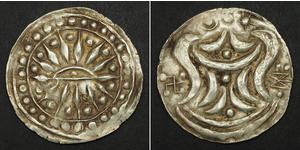96 Ratti (sold for $58.0)
Burma, Pyu Kingdom of Bekthano (550-627 AD) Silver Unit (96 Rattis) Coin. VF+
Reference: Mithciner 2578 var. Denominations: Silver Unit (96 Rattis) Mint Perio6th Century (550-627 AD) Condition: Light rusty deposits, struck on a smallish, but thick planchet with a late devolved style, which shows the swastika as a cross with four pellets, otherwise VF+ Diameter: 29mm Material: Silver Weight: 9.1gm
Obverse: Rising sun with pellets between rays. All within a border of pellets.
Reverse: Stylized temple, flanked by stylized swastika (devolved to a cross with four pellets - left) and stylized Damaru symbol (right). Moon and sun above, three pellets below.
Beikthano (Burmese: ဗိဿနိုး [beɪʔθənó]) situated in the irrigated Minbu region (near present-day Taungdwingyi) with direct land access to the well-watered Kyaukse plains to its northeast, is the oldest urban site so far discovered and scientifically excavated site. Its remains—the structures, pottery, artefacts, and human skeletons—date from 200 BCE to 100 CE. Named after the Hindu god Vishnu, the city may be the first capital of a culturally and perhaps even politically uniform state in the history of Burma. It was a large fortified settlement, measuring approximately 300 hectares inside the rectangular (3 km by 1 km) walls. The walls and fortifications along it measured six meters thick, and are radiocarbon dated to a period between 180 BCE and 610 CE. Like most subsequent cities, the main entrance of the walls led to the palace, which faced east. Stupas and monastic buildings have also been excavated within the city walls.
The Pyu city states (Burmese: ပျူ မြို့ပြ နိုင်ငံများ) were a group of city-states that existed from c. 2nd century BCE to c. mid-11th century in present-day Upper Burma (Myanmar). The city-states were founded as part of the southward migration by the Tibeto-Burman-speaking Pyu people, the earliest inhabitants of Burma of whom records are extant. The thousand-year period, often referred to as the Pyu millennium, linked the Bronze Age to the beginning of the classical states period when the Pagan Kingdom emerged in the late 9th century.
The city-states—five major walled cities and several smaller towns have been excavated—were all located in the three main irrigated regions of Upper Burma: the Mu River Valley, the Kyaukse plains and Minbu region, around the confluence of the Irrawaddy and Chindwin Rivers. Part of an overland trade route between China and India, the Pyu realm gradually expanded south. Halin, founded in the 1st century AD at the northern edge of Upper Burma, was the largest and most important city until around the 7th or 8th century when it was superseded by Sri Ksetra (near modern Pyay) at the southern edge. Twice as large as Halin, Sri Ksetra was the largest and most influential Pyu centre.
The Pyu culture was heavily influenced by trade with India, importing Buddhism as well as other cultural, architectural and political concepts, which would have an enduring influence on the Culture of Burma and political organisation. The Pyu calendar, based on the Buddhist calendar, later became the Burmese calendar. Recent scholarship, though yet not settled, suggests that the Pyu script, based on the Indian Brahmi script, may have been the source of the Burmese script used to write the Burmese language.
The millennium-old civilisation came crashing down in the 9th century when the city-states were destroyed by repeated invasions from the Kingdom of Nanzhao. The Bamar people, who came from Nanzhao, set up a garrison town at Bagan at the confluence of the Irrawaddy and Chindwin Rivers. Pyu settlements remained in Upper Burma for the next three centuries but the Pyu gradually were absorbed into the expanding Pagan Kingdom. The Pyu language still existed until the late 12th century. By the 13th century, the Pyu had assumed the Burman ethnicity. The histories and legends of the Pyu were also incorporated to those of the Bamar.
Only the city-states of Halin, Beikthano and Sri Ksetra are designated as UNESCO World Heritage Sites, where the other sites can be added in the future for an extension nomination.
Only 1$ shipping for each additional coin purchased!

|
Posted by:
anonymous 2017-05-12 |
|
||
|
||
|
||
1 Ducat Kingdom of the Netherlands (1815 - ) Gold
group has 15 coins / 14 prices
⇑




 Deutsch
Deutsch Русский
Русский Українська
Українська English
English Italiano
Italiano Français
Français Español
Español 汉语
汉语






-300-150-S5IKbzbiDHkAAAFLS6rk0KRZ.jpg)






